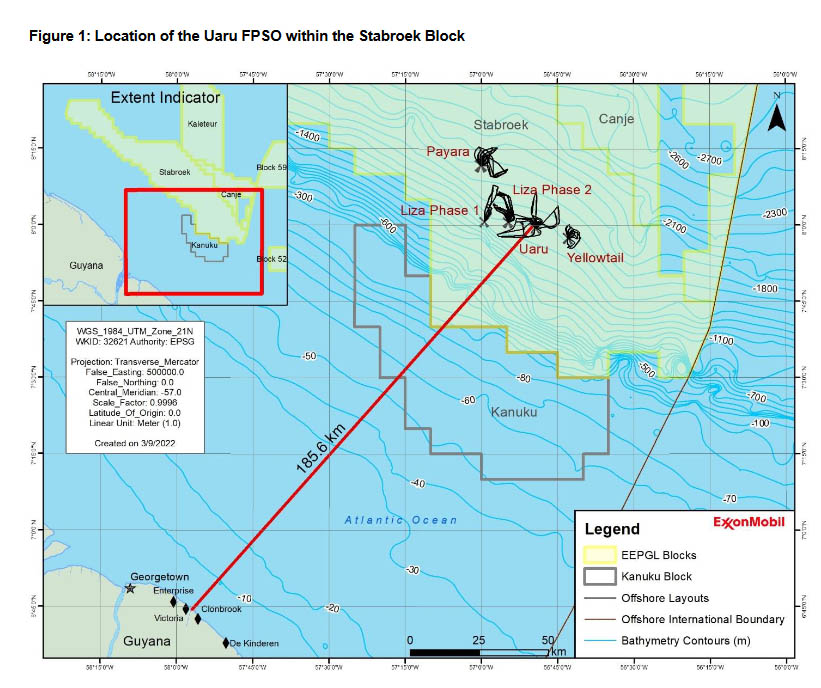The Environmental Protection Agency (EPA) yesterday said that ExxonMobil’s proposed Uaru well development in the Atlantic will require an impact study and if the go-ahead is given it would see a total of more than one million barrels of oil per day being extracted from five platforms by the second quarter of 2027.
Yesterday, less than a month after receiving the application for a fifth oil project from ExxonMobil’s subsidiary, EEPGL, the EPA said that an Environmental Impact Assessment (EIA) was necessary and it also simultaneously published a summary of the project.
Members of the public now have 28 days from yesterday to make written submissions to the Agency, setting out those questions and matters which they require to be answered or considered in the EIA.
The EIA process for the Esso Exploration and Production Guyana Limited (EEPGL) projects has been controversial and has seen members of the public and environmentalists accusing the government and the EPA of violating key aspects of the law and not taking objections seriously. This has been particularly so for the just concluded Yellowtail well development. Oil is being extracted from Liza-1 and Liza-2 wells and plans are underway for the third and fourth wells: Payara and Yellowtail.
A key complaint by environmentalists is that one consulting firm, ERM has done all of the work on the EEPGL applications and this has created a mutually beneficial relationship between the two. Further, the governing act requires the selection of the consultant “with the assistance of internationally recognized environmental groups” and this has not occurred. There will be great interest in how the EPA selects the consultant for this project.
According to the EEPGL summary, the Uaru Development Project will be designed to add up to 250,000 barrels of oil a day to existing daily production volumes in Guyana. The Liza-1 is producing at 120,000 barrels per day, the Liza-2 has a capacity of 220,000 barrels, Payara 220,000 and Yellowtail 250,000.
In its non-technical summary of the project, EEPGL said that approximately 40 to 76 wells will be drilled offshore to support extraction of the oil from below the sea floor.
The project will be located in the eastern portion of the Stabroek Block, approximately 200 km from Georgetown. Oil production from Uaru is expected to last approximately 20 to 30 years.
EEPGL will install some of the oil production facilities on the sea floor at approximately 1,450 – 1,950 m water depth. These subsea facilities include various types of pipes and hardware.
The Floating Production, Storage and Offloading vessel (FPSO) will be moored on location in approximately 1,690 m of water depth and will remain on
location throughout the production stage. The FPSO will have the peak capacity to produce up to approximately 220,000 barrels to 275,000 barrels of oil per day. The summary said that these estimates are preliminary and are subject to change.
Processed oil will be stored in cargo tanks inside the FPSO hull which have the capacity to hold approximately two million barrels of oil.
During peak production, approximately every four days, the oil will be pumped from the FPSO to a conventional oil tanker, which is owned/operated by third parties.
At peak, the summary said that EEPGL will utilize approximately 1,200 personnel offshore during the stage where the wells are being drilled and the offshore oil production facilities are being installed. This number will decrease to less than 200 personnel during the production phase. A smaller number of personnel will be utilized at the onshore support facilities.
The summary said that project activities may have the following impacts on people, wildlife, and the environment:· Changes in quality of air and increases in greenhouse gas emissions· Changes in noise and light levels· Disturbance of seabed· Changes in quality of ocean water· Impacts to whales, dolphins, sea turtles, fish, marine birds, and marine protected species. Impacts to coastal wildlife and/or coastal habitat· Changes in food sources for fish and wildlife· Increase in number of available local jobs· Increase in government revenue· Increase in foreign workers· Increased demand for local goods and services· Increased demand for local accommodations·
Increased road and vessel traffic and use of local shore bases
· Restriction on fishing around drill ships (temporary) and FPSO· In the unlikely event of an oil spill, impacts to the environment (e.g., marine waters, coastline, protected areas), indigenous communities, and livelihoods of farmers and fishermen
· Cumulative impacts
The summary said that the potential impacts, which are expected to be similar to those identified in the Stabroek Development EIAs, could be directly and/or indirectly generated by Uaru during drilling and installation, hook-up and commissioning, production, and/or decommissioning operations, and such impacts could be adverse or positive in nature. It added that the potential for cumulative impacts exists
where impacts from Uaru overlap with those of Stabroek Projects (or other existing or planned future activities) in space or time.
“As such, a robust cumulative impact assessment will be performed as part of the Uaru assessment of impacts”, it said.
EEPGL said it will operate in a manner that minimizes environmental impacts to air, water, land, and social infrastructure and protects the health of people and animals.
“EEPGL continues to apply the learnings of Liza Phase 1 and will benefit from the experiences of starting up and operating Liza Phase 2. EEPGL has undertaken additional studies to obtain an even more comprehensive understanding of potential impacts of effluent discharges to water, the feasibility of alternative handling of produced water, cradle to grave waste management in Guyana, emergency response capabilities, and environmental compliance monitoring and verification. The learnings from current operations and environmental studies will enhance the design and implementation of the Uaru Project, increasing environmental performance and economic value”, the summary said.
The Project has been designed for no routine flaring of associated gas by instead planning to use the gas for fuel, or reinjecting it into reservoirs to improve oil recovery. The summary said that this design is consistent with ExxonMobil’s plans to align with the World Bank’s initiative to eliminate routine flaring by 2030.
“However, it is important to recognize that some flaring is necessary or inevitable to maintain safe and reliable oil and gas operations. Such flaring will for example include well testing, background operational and safety flaring, planned maintenance activities, and intermittent unplanned events associated with process upsets or temporary infrastructure (equipment) malfunction”, the summary said.
The FPSO will treat produced water before discharging it overboard. The treated produced water will be decanted overboard as per industry best practices. In addition, the FPSO will use treated sea water for cooling and injection into the reservoir for additional pressure maintenance. The cooling water will also be discharged overboard.
The proposed FPSO will be a newly built floating facility with double hull protection, with approximate dimensions of 354 m long by 64 m wide by 33 m deep, and will be moored on location, approximately 200 km offshore, some 10 km to the east of the Liza Unity FPSO.
The summary said that should an EIA be required by the EPA, EEPGL will “scope, study, and assess potential impacts from the Uaru Development Project in an EIA per the laws of Guyana, in particular the Environmental Protection Act 1996. Through an EIA, EEPGL and those qualified independent environmental consultants chosen and approved to conduct the EIA will study and assess the significance of potential impacts generated by the Project, and will identify mitigation measures and monitoring programs to address any identified adverse impacts of significance”.
The summary of the project can be viewed on the EPA’s website or uplifted at the Office at the cost of photocopying.
Comments should be addressed to:
The Executive Director
Environmental Protection Agency
Ganges Street, Sophia, Georgetown, Guyana.
Phone: 592-225-0506 Fax: 592-225-5481
E-mail epa@epaguyana.org
Website: www.epaguyana.org






